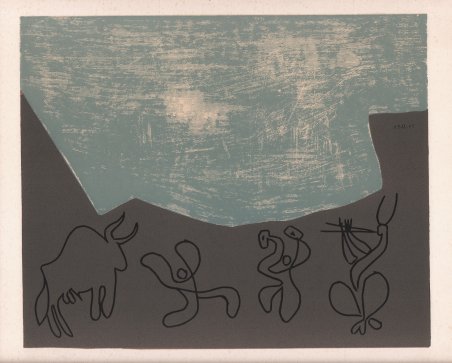Il Baccanale, ovvero celebri cerimonie organizzate in onore del Dio Bacco, erano uno dei temi maggiormente illustrati da Pablo Picasso. L'artista dedica una vastissima produzione a queste tematiche gioiose di festa, con la quale si trova particolarmente in sintonia, dato il suo amore per la vita mondana, il vino e le donne. dal 1946. Sposatisi nel 1961 a Vallauris, Jacqueline sarà presente fino alla morte di Picasso nel 1973. Originariamente rilegata nella prima edizione del ' Picasso Linogravures, ' (con la firma e il numero a matita di Pablo Picasso), questa straordinaria linoleografia fu pubblicata in un'edizione limitata di 50 copie (Casa editrice Gerd Hatje, Stoccarda 1962). Nella introduzione del libro ' Picasso Linogravures, ' pubblicato Gerd Hatje, ' Stuttgart ' and ' Éditions Cercle d’Art, Paris in 1962, ' Wilhem Boeck spiega il perchè Picasso ha iniziato a realizzare libri con questo tipo di tecnica di stampa: “Picasso ' had recently become an adept of cut-linoleum printing. It was a new activity, and doubtless owed to the artist’s desire to give colour pride of place within printed creations when graphic arts had, until then, consigned it to a subordinate role – even in lithography. Taking up the gouge was less, for Picasso, about exploring a new realm of objects and forms, then exposing the forms he had mastered to the rigours of as-yet untested technical possibilities. As he did every time he embarked on a new task, be it sculpture, lithography, ceramics or aquatints, the result obtained can be compared to nothing but previous creations by Picasso himself”. Picasso ha inventato il metodo della riduzione, tagliando progressivamente lo stesso blocco di linoleum per ogni nuovo colore. Nel 1962, in collaborazione con Picasso e la Galerie Louise Leiris, sono state realizzate nuove lastre di linoleum al 42% della dimensione originale, ed è da queste che sono state realizzate le stampe [Dimensioni: 12,6 x 14,2 in (32 x 36 cm)], per l’edizione Circle d'Art, Parigi 1962. Queste linoleografie sono rinomate per la loro alta qualità e fedeltà a Picasso. Una bella impressione con colori freschi e margini pieni. ' Bibliografia Bloch, G. (1984). ' Pablo Picasso, Tome I Catalogue de l’œuvre grave et lithographié 1904 – 1967, n. 923. The Bacchanal, or celebrated ceremonies organized in honor of the God Bacchus, were one of the themes most illustrated by Pablo Picasso. The artist devoted a vast production to these joyous festive themes, with which he was particularly attuned, given his love of the mundane, wine and women. Originally bound into the first edition of picasso linogravures (with the signature and number in pencil by Pablo Picasso), this extraordinary linocut was published in a limited edition of 50. In the introduction of the book, published by ' Verlag Gerd Hatje, ' Stuttgart ' and ' Éditions Cercle d’Art, Paris in 1962, ' Wilhem Boeck ' tells us why the great artist started to make a book with this printing technique: “Picasso ' had recently become an adept of cut-linoleum printing. It was a new activity, and doubtless owed to the artist’s desire to give colour pride of place within printed creations when graphic arts had, until then, consigned it to a subordinate role – even in lithography. Taking up the gouge was less, for Picasso, about exploring a new realm of objects and forms, then exposing the forms he had mastered to the rigours of as-yet untested technical possibilities. As he did every time he embarked on a new task, be it sculpture, lithography, ceramics or aquatints, the result obtained can be compared to nothing but previous creations by Picasso himself”. Picasso invented the ereduction method, progressively cutting the same linoblock for each new colour, ' making it impossible to take any further prints from the original plates. In 1962, in collaboration with Picasso and Galerie Louise Leiris, new linoleum plates were made at 42% of the original size, and it was from these that the prints were made [Size: 12.6 x 14.2 in (32 x 36 cm)]. For France edition Circle d'Art, Paris 1962. These linocuts are renowned for their high quality and fidelity to Picasso's. A fine impression with fresh colors and full margins. Bibliografia Bloch, G. (1984). ' Pablo Picasso, Tome I Catalogue de l’œuvre grave et lithographié 1904 – 1967, n. 923. Cfr.

Find out how to use
Find out how to use

